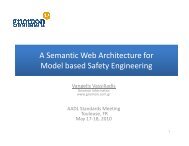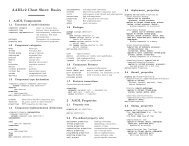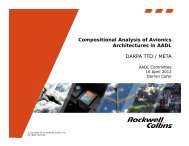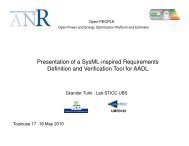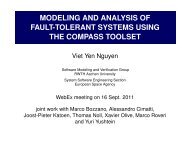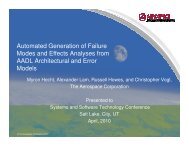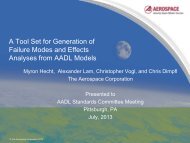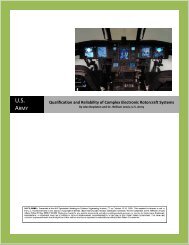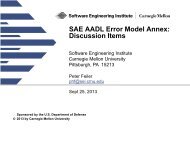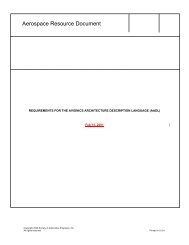Integrating Formal Model Checking with the RTEdgeTM AADL ...
Integrating Formal Model Checking with the RTEdgeTM AADL ...
Integrating Formal Model Checking with the RTEdgeTM AADL ...
- No tags were found...
Create successful ePaper yourself
Turn your PDF publications into a flip-book with our unique Google optimized e-Paper software.
<strong>Integrating</strong> <strong>Formal</strong> <strong>Model</strong> <strong>Checking</strong> <strong>with</strong><strong>the</strong> <strong>RTEdgeTM</strong> <strong>AADL</strong> MicrokernelSerban GheorgheEdgewater Computer Systems Incserban.gheorghe@edgewater.ca1
What is RTEdge TMRTEdge TM is a software development environment For Proof Based, <strong>Model</strong> Driven Development (MDD) of Modal Software Systems Built on a language subset of <strong>the</strong> <strong>AADL</strong> and UML2• conceptually similar to <strong>the</strong> ADA Spark / Ravenscar subsetsMain goal: assist in <strong>the</strong> construction of <strong>the</strong>oretically correct real-timeapplications• Hard real-time software systems• Mission critical software systems• Real-time systems distributed over communication networksRTEdge TM approach: convergence of three software engineeringtechnologiesSubset of<strong>AADL</strong>sw componentmodelSubset of<strong>AADL</strong>executionsemantics1. <strong>Model</strong> Driven Development (MDD)2. Component based specification and design3. Proof based engineering :1. Timing constraints checked by ma<strong>the</strong>matical proofUML2 concepts:Component Interfaces:Ports typed by Protocol contractsComponent Behavior:State Machine Subset2. Functional correctness checked through static analysis and formal modelchecking2
RTEdge TM as a subset of <strong>AADL</strong> sw component modelComponentTypeSystem<strong>AADL</strong> component_category ::=abstract_component_categoryComponentImplementationProcessThread GroupThreadData| composite_category| execution_platform_category| software_categoryRTEdge DeploymentObjectsRTEdge Components:Composite Capsule (CC)Atomic Capsule (AC)SpecificationTypesImplementationTypesMemoryProcessorBusDeviceVirtual ProcessorVirtual BusComponentTypeComponentImplementationSubprogramSubprogram GroupComponentTypeComponentImplementationRTEdge Atomic Capsulebehaviour:Finite State Machines <strong>with</strong>embedded ProgrammingLanguage Functions calls(Misra C, o<strong>the</strong>r)33
RTEdge TM as a subset of <strong>AADL</strong> execution semantics<strong>AADL</strong> <strong>Model</strong>RTEdge Language SubsetCodeGenerationRTEdge Code generated from <strong>AADL</strong>Support <strong>AADL</strong> Thread Dispatch Modes- Periodic,Sporadic, Aperiodic,Timed and HybridSupport <strong>AADL</strong> inter-thread communication/synchronization semanticsC CodeGenerationRTEdge Runtime Exec SemanticsAsynchronous Message Passing ExecutiveTime constrained Discrete Events only<strong>AADL</strong> Threads Atomic CapsulesThreads <strong>with</strong> FSM behavior, purely reactiveFeatures subset- Event/Event Data Ports- Required/Provides Data Ports- FSM behavior, a subset of UML SM<strong>AADL</strong> Thread Groups Composite CapsulesResolved to communicating Atomic CapsulesPeriodic Timer ServiceBounded OverheadsRun-time Executive4
Analyzing,Deploying and Debugging <strong>AADL</strong> SoftwareOSATE <strong>AADL</strong> <strong>Model</strong>P1CodeGenerationP2AbstractP3_RTEdgeRTEdge Language SubsetP1_CCP2_CCP3_CC• A mixture of threads <strong>with</strong> Periodicand Aperiodic behavior• Flow Path Feasibility Analysis• Deadline Monotonic PriorityAssignment based on Flow deadlines• WCRT Analysis• Port Buffer Queue size analysis• Use of RTEdge <strong>Formal</strong> <strong>Checking</strong>MechanismsC CodeGenerationRTEdge Runtime Exec SemanticsExecutable E1Executable E2Debug at model levelConsistent Execution SemanticsBounded Overheads ExecutiveHWPlatform 1HWPlatform 25
Trust Layers for execution semantics<strong>AADL</strong> <strong>Model</strong>P1P2AbstractP3_RTEdgeSynchronousAnnex <strong>Formal</strong>Semantics (??)AsynchronousAnnex <strong>Formal</strong>Semantics (??)RTEdge Language SubsetP3_CCP1_CCP2_CCRTEdge TM Application <strong>Formal</strong> Properties• User defined Safety and Liveness properties• <strong>Formal</strong> <strong>Model</strong> <strong>Checking</strong> Spin/Promela• Evolution to <strong>Formal</strong> Compositional VerificationRTEdge RuntimeExec Semantics • <strong>Formal</strong>ly defined operational semantics• Axiomatic semantics – Theorem proving• Explore use of BLESS6
Crossing <strong>the</strong> “V”The <strong>AADL</strong> Spec covers many possible types of execution semantics(95) A method of implementing a system is permitted to choose how executing threads will be scheduled.A method of implementation is required to verify to <strong>the</strong> required level of assurance that <strong>the</strong> resultingschedule satisfies <strong>the</strong> period and deadline properties. (<strong>AADL</strong> 2 Spec, page 94)Static <strong>Model</strong> Analysis Tools• huge cost savings benefitsthrough early problem resolutionHOWEVER• must have intimate knowledge of1. Execution State Space2. Target Execution Semantics<strong>Model</strong> Transformation toexecutable, target deployablecode creates a semanticdiscontinuitySingle Source of Truth:Deployed Software ComponentsIntegration and Debuggingmust be performed in <strong>the</strong>context of <strong>the</strong> <strong>Model</strong>sThe effectiveness of Real-time and Functional Static Analysis Tools depends on<strong>the</strong> enforcement of a well defined Execution State Space and Target ExecutionSemantics7
The RTEdge TM /<strong>AADL</strong> SolutionRTEdge ToolsProgrammingLanguageSpecification<strong>Model</strong>HLD <strong>Model</strong>Implementation <strong>Model</strong>User ApplicationHardware Abstraction Layer (HAL)HWPlatform 1Run-Time EXECHWPlatform 2Virtual TimePlatformVirtual Time Simulation Platform• Enable execution of software components onhost desktop computers by emulatingtarget hardware real-time behaviourReal Time AnalysisToolFunctional PropertiesAnalysis ToolCode Generator ToolThe Code Generator andProof Tools for Real-Timeand Functional Propertiesassume a well definedRTEdge/<strong>AADL</strong> subsetexecution semantics• The <strong>AADL</strong> subset execution semanticsassumed by <strong>the</strong> Code Generator and ProofTools is implemented and enforced in a HWindependent Run-Time Exec library• HAL adaptation of Run-Time Exec to multipleplatforms• A host RTOS is assumed on <strong>the</strong> HW Platform8
Protocol Contracts for Software ComponentsConjugatedRole PortP 1C 1 A 0 C 0BaseRole PortC 1C 0‘protocol’ A 0Output/RequiredEventres_ackres_infoDatares_id_uint16reservation_structInput/ProvidedEventres_requestres_cancelres_queryDatareservation_structres_id_uint16Assumptions SERE Protocol of State Signals on Machines + Data Signal Assertions + Order Data Constraints (IEEE1850) and DataThe UML2 concept of Protocol is used in RTEdge as a specification mechanism:• capturing and refining interaction Assumptions-Guarantee contracts• conformance / consistence when implementing or composing Software Components10
More on RTEdge TM – Application <strong>Model</strong>RT Ports Components andProtocols (Capsules)RTEdge TM Application• An Application maps into one RTOS Task- resolves to set of concurrent Atomic Capsule (AC)Finite State Machines (FSM)- built-in FSM event priority scheduling• Closed System <strong>Model</strong> Definition:- “External Tasks” model environment RTOS TasksI/O behavior and processor demands- Independent Input time arrival specification(Period, Jitter, Jitter bounds)RTEdge Dispatch Event types:• Independent Input arrival• Signal Events received at Port FIFOs• AC Transient State Activity Completion- Static Event priority assignment- Deadline MonotonicApplication Flows Specification:Event Flows <strong>with</strong> Real-Time Contracts• Arrival spec (Period,Jitter)• DeadlineEvent Flow: a specification of a causal relationship between an ordered pair of RTEdge TM Dispatch EventsKey concepts:• PROCESSOR and COMMS resource scheduling are based on Event Flows• RTEdge automatically calculates:• Application implementation Flow paths and• Worst-Case Response Times for each Event Flow based on Execution costs11
More on RTEdge TM - TransactionsA Transaction is <strong>the</strong> set of Event Flows originated from an Independent Input• Conditional Flow Paths can happenin AC FSMs• Flows can end on AC FSM StatesTransactions can share ACFSM InstancesCC2DAdjust_ctrlCalibrate_ctrlSensor_InECC1RecalibrateABCalibrate_o<strong>the</strong>rSending a Signal Event through a Portcreates a concurrent Flow Path• A Transaction is complete when all <strong>the</strong> downstream events caused by <strong>the</strong> Independent Input have beenconsumed• Indicates no State Machines Deadlock (events not consumed) or Livelock (infinite event loops)12
<strong>Formal</strong> <strong>Model</strong> <strong>Checking</strong> WorkflowsDefine, Translate and Verify Application Annotations expressing UserDefined <strong>Formal</strong> PropertiesStep-wise<strong>Model</strong>RefinementApplication<strong>Model</strong> inRTEdgeCounter-exampleInterpretationUser Defined Behavioral AssumptionsRTEdge to PromelaTranslationUser Defined Assertions (Safety)Translation OptionsApplication<strong>Model</strong> inPromelaCounter-examplesSpinStatic Analysis ToolsCodeGenerationUser Defined Safety or LivenessProperties expressed as LTLRTEdge Application AnnotationsPromela Assertions and Invalid End StatesLTL FormulaRTEdge TMToolsetApplicationExecutablePromela-SpinTool Framework1313
Solution Issues -Mapping RTEdge TM Applications into PromelaRTEdge TM Application as a Closed SystemExtTask1Sensor_InRecalibrateCC2DEACC1BAdjust_ctrlCalibrate_ctrlExtTask2Calibrate_o<strong>the</strong>rLTLIndependentInputsGeneratorPromelaProcesstranslatedfrom ExternalTasksDispatchProcessenforcesRTEdge TMEventsdispatchusingrendez-vouschannelsPromelaInputGeneratorProcessEach AC Instance istranslated into aPromela ProcessEEach two-way Port Connectionis mapped into two receiveFIFO channelsInput Generation TranslationDRTExec Dispatch Promela ProcessABPromelaNever ClaimProcess14
Solution Issues -Annotating <strong>the</strong> RTEdge TM Application <strong>Model</strong>RTEdgeApplication+PropertySpecifications <strong>Checking</strong> properties are specified as Annotations to a deployable RTEdgeApplication: Seven types of Annotations have been defined:ANNOTATION TYPE INTENDED USE - GCV (GCC) Global <strong>Checking</strong> Vars/Const - AC Instance Behaviour Annotation - <strong>Checking</strong> Assertions:• Inline <strong>Checking</strong> Assertion• AC Instance <strong>Checking</strong> Assertion• Application Scope <strong>Checking</strong> Assertion Input Data Range Constraints User Defined LTL Formula Transient State Behavioural Annotation Execution Condition AnnotationDefine Verification Meta-Variables and<strong>the</strong>ir behavior through assignmentsDefine Assertions on Meta-Variablesand App State Variables Expressions<strong>with</strong> Different Evaluation ScopeControl Size of <strong>the</strong> Input State SpaceDefine Temporal Logic App PropertiesAbstract out State Machine ActivityC Code15
Defining meta-behavior Annotations(Application <strong>Checking</strong> View)Global <strong>Checking</strong> Variables/Constants (GCV or GCC)ApplicationInputsUser-defined or Tool-generated meta-variablesdeclared outside <strong>the</strong> RTEdge Application statespace and accessible in any AnnotationAny basic data type supported by Promela/SpinTool-generated GCVs are created for use by <strong>the</strong>tool-generated LTL formula;documented behavior<strong>the</strong>y can also be used in o<strong>the</strong>r user-defined AnnotationsAtomicCapsule(AC)InstancesAC Instance Behavior AnnotationsUsed to define GCV behavior through conditionalassignmentsCheck_GCV = (attr.y > 1) -> (attr.x + Increment_GCC) : (Fail_GCV)Attached to an AC Instance state machine TransitionExecuted inline wherever <strong>the</strong> Annotation is placedCounter-examples16
Defining AssertionsApplication <strong>Checking</strong> ViewApplicationInputsCapsuleInstances<strong>Checking</strong> AssertionRelational Expressions of GCVs, GCCs and in scopeAtomic Capsule AttributesUsed to verify safety conditions to which anApplication must complyA finding is raised if condition returns falseApplication Scope <strong>Checking</strong> Assertionsattached to an Application and evaluated on everychange of <strong>the</strong> global RTEdge Application state space(every AC instance state machine Transition)AC Instance <strong>Checking</strong> Assertionsattached to capsule instances and evaluated on everyTransition <strong>with</strong>in its state machineIn-line <strong>Checking</strong> Assertionsattached to state machine Transitions and evaluatedwhen <strong>the</strong> Transition is takenCounter-examplesExamples:Check_GCV >= 10(myDap.x < Status_GCC) && (Check_GCV < attr.y)17
Defining Input Data Range Constraints(Application <strong>Checking</strong> View)ApplicationInputsInput Data Range ConstraintsCapsuleInstancesAffect <strong>the</strong> Application state spaceRestrict <strong>the</strong> range of values for SystemInputs Mechanism for reducing <strong>the</strong> size of <strong>the</strong>Application input space Attached to Application Inputs in <strong>the</strong>Application <strong>Checking</strong> View Can reference Global <strong>Checking</strong>ConstantsCounter-examplesExample:(sd_struct.b[0]: 5,8,12..15;);18
Defining Transient State Behavior Annotation(Application <strong>Checking</strong> View)ApplicationInputsTransient State Behavior Annotations andExecution ConditionsCapsuleInstancesUsed as an abstraction mechanism for ACActivities attached to Transient States <strong>the</strong>y do modify <strong>the</strong> Application state space (ACAttributes)Transient State Behavior Annotation: used todefine how <strong>the</strong> state’s Activity code wouldmodify local dataExecution Condition: attached to Transitionsthat exit Transient States, used to defineconditions under which that Transition is takenCounter-examplesDefault Promela Translation OptionUse Transient State C Activity Codec_track, c-code, c_expr fetaures of Spin for embeddingimplementation code in <strong>the</strong> Verifier executableEdgewater Computer Systems – Confidential Commercial Information 19
Solution Issues -RTEdge TM -Promela Verification Options<strong>Checking</strong> Context Translation Options SelectionsOption Value LTL RunDefault in redSafety RunsInclude Priorities On X XOffXSafety X XVerification TypeIndependent InputSignal GenerationLTL OptionAcceptanceNon-ProgressGuaranteed Arrival In Hyper-Period (WeakFairness & Bounded Jitter)XX X XAll orders in Hyper-Period (Weak Fairnessor X or X or Xand Unbounded Jitter)All orders (no Weak Fairness & UnboundedJitter)Tool Generatedor Xor XXor XNo LTL X XUser DefinedO<strong>the</strong>r conditions:all Activity C-Code IncludedAbstraction Level relative to <strong>the</strong> concreteRTEdge TM ApplicationYes Yes YesBi-simulation ofRTEdgeDispatchEventsBi-simulationof RTEdgeDispatchEventsOverapproximationFalse Positives NO NO NOFalse Negatives (Counter-Examples) NO NO Possible21
Solution Issues -Interpreting <strong>the</strong> counter-exampleOpen InterpretedCounter-ExampleHover to displayfully qualified ACInstance nameCtrl-Click to navigate to<strong>the</strong> AC Instance FSM Support is provided to relate a line from <strong>the</strong> counter-example file to <strong>the</strong>RTEdge TM Application model Atomic Capsules in <strong>the</strong> concrete Application are mapped into Promelaprocesses <strong>with</strong> shortened names Meta-data is generated in <strong>the</strong> Promela files to help map short form PromelaProcess names to fully qualified names for AC instances22
Verifying through <strong>Model</strong> <strong>Checking</strong> <strong>the</strong> RTEdge TMSchedulability Analysis AlgorithmModified Lehoczky, Harbour Klein Algorithm for Fixed Priority Task Set <strong>with</strong> Precedence Linear precedence sub-tasks of original algorithm supplemented <strong>with</strong> Conditional execution nodes Parallel (fork) nodes Bounded Cyclesto reflect RTEdge Transaction graphs1. Static Priorities are assigned per event and state based on deadlines (DMS)2. Priorities are statically adjusted based on resource usage (priority ceiling protocol)3. Create task system from model (all RTEdge Transactions originated in Independent Inputs) each task is modeled as a graph of subtasks (AC Activities) <strong>with</strong> cycles and conditional paths ensure cycles are bounded by user-supplied bounds4. calculate Worst Case Response Time (WCRT) calculate utilization, give up if greater than one for each task• determine worst case phasing, interference, blocking• calculate WCRT for each subtask, compare <strong>with</strong> deadlinesUsing <strong>Formal</strong> Link Annotations, we can verify <strong>the</strong> correctness of <strong>the</strong> WCRT analysis for a model1) Assume tool calculated WCRT is correct2) Define an execution time accumulator GCV per Transaction and behavior to keep updated233) Prove as a safety property on every execution path that WCRT can’t be exceeded 23Edgewater Computer Systems – Confidential Commercial Information 23
<strong>Formal</strong> Link Next Stage Additional Annotations Adaptation of IEEE 1850 Property Specification Language (PSL) to RTEdgeProtocols, Capsule Interfaces and Capsule compositions Signal sequences specified as IEEE1850 PSL Sequential Extended RegularExpressions (SERE) of Signals• Regular Expressions of Signals on Protocols• Regular Expressions of Signals on Capsule Interfaces• Regular Expressions of Signals on Ports of Capsule Roles contained in aComposite Capsule type Provide a formal framework for hierarchical Compositional Verification forcomponent based applications Individual Component implementations investigated for conformance to formalCapsule Interface specification Specification of aggregated components can be checked for• consistency and conformance to <strong>the</strong> container Capsule Interface formal spec24



